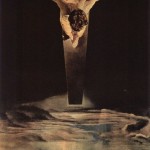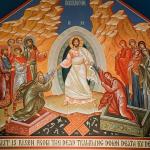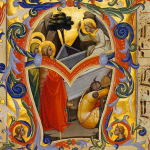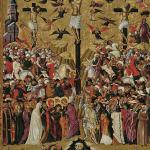The Two Standards is one of the most well-known meditations of St Ignatius of Loyola’s Spiritual Exercises. One is invited to imagine, in Ignatius’ 16th century Spanish military man language, two great armies, under two standards: the army of Christ and the army of the Devil, and make a choice.
The Two Standards is also the title of, by many accounts, one of the masterpieces of 20th century French literature. It describes a unique kind of love triangle, in the bourgeois world of 1920s Lyon, the stifling provincial bourgeoisie that features so prominently in French novels. Régis and Anne-Marie are two young people who are madly in love. They spend a night together, chastely, in the hills surrounding Lyon, during which they have a mystical experience; following this experience, they decide to enter into a kind of spiritual marriage, each entering the religious life, Régis with the Jesuits. Régis’ childhood friend Michel, a “cultured despiser” of Christianity and aspiring writer, is fascinated by their strange story. He falls in love with Anne-Marie, and then with religion, and then out of love with religion, becoming a sort of Nietzschean figure. As Régis enters the Jesuit novitiate, his rigoristic confessor orders him to break contact with Anne-Marie; Anne-Marie and Michel run away into a torrid affair (one gets the sense that Michel seduces Anne-Marie at least in part out of spite against Régis or what he represents); Anne-Marie eventually leaves both men, entering a hedonistic bohemian lifestyle with the same abandon she devoted to religion; Michel tries to destroy Régis, confronting him with the idea that Anne-Marie’s self-destructive behavior is because he selfishly and pridefully tried to mold her into something she never was. The novel ends very inconclusively.
The novel is based on a true story. “Michel” is the author, Lucien Rebatet, who would become a fascist writer and a Nazi collaborator and was sentenced to death after World War II (the author’s infamy contributing to The Two Standards remaining under the radar). “Anne-Marie” is Simone Chevallier, who would become a noteworthy Parisian writer, poet and literary salon holder, and be in part known for her tempestuous romances with both men and women. “Régis” is François Varillon, SJ, who would become one of the greatest spiritual and theological writers of the 20th century (and a personal hero of mine). Varillon would eventually petition for Rebatet’s death sentence to be commuted (which it was; he wrote The Two Standards in prison) and would say a mass each year for Simone and Lucien, on the anniversary date of their mystical night. There is some controversy about what parts of the novel are real; Simone wrote her own version denying that she ever had an affair with Rebatet, but given the latter’s post-war infamy there is some reason to doubt her honesty; for his part, Varillon never commented publicly, although a friend tells me many of Varillon’s writings are implicit responses to the arguments against religion present in The Two Standards.
The novel is a dense 1300 pages full of meditations on music, culture, religion, spirituality, society, love, sex (hetero and not), and much more. I haven’t read it (yet) but I saw a play adaptation yesterday, which is why I am writing this post. In the play, and I don’t know if this is a later interpolation or not, there is a revolutionary flavor to Anne-Marie and Régis’ original design: to model a kind of revolutionary love, chaste and spiritual, over and against both stifling bourgeois moralism and sophisticated hedonism.
In any case, what a story! And yes, the “based on true events” part plays its role. The love triangle is one of the oldest motifs in literature, but this one is of a special kind, because of the chaste and spiritual element. Walking into the theater, I wondered whether that part would “feel credible” in the 21st century, but I found that it did. The revolutionary, messianic fervor of the longing for purely spiritual love intersects with the real-world messiness of human lives in an explosive way. The themes of love, God, religion, atheism, morality, social conformity, sex, culture, etc. intersect in myriad ways. I dread to read a large tome when there is already so much on my “to read” pile, but at the same time I find myself inescapably fascinated with these characters and this story.
Ultimately, there are two standards. Which will you choose?















